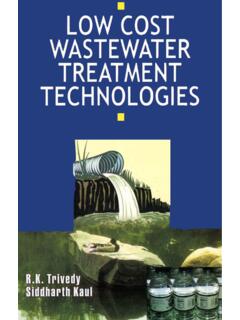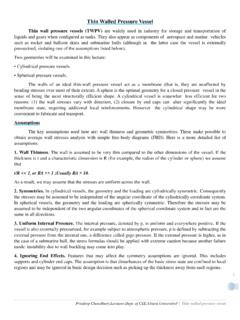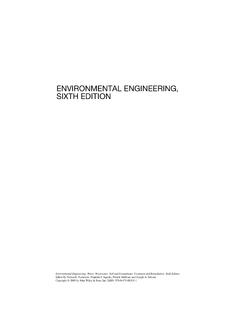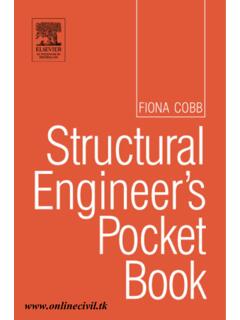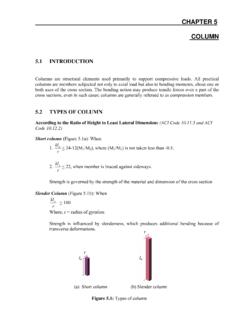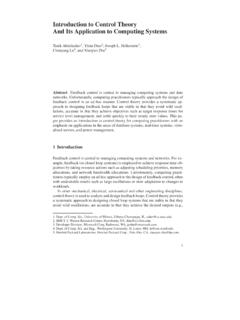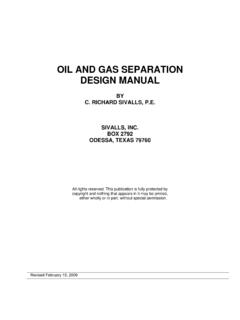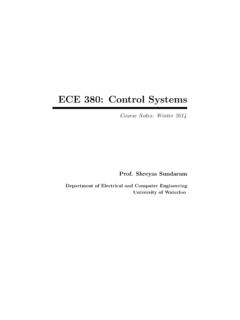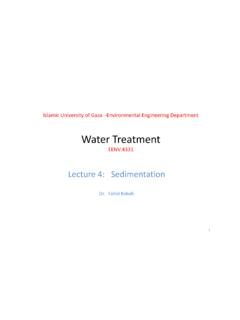Transcription of Fundamentals of Wastewater Treatment and Engineering
1 ISBN: 978-0-415-66958-09 780415 66958090000 Environmental EngineeringAs the world s population has increased, sources of clean water have decreased, shifting the focus toward pollution reduction and control. Disposal of wastes and Wastewater without Treatment is no longer an option. Fundamentals of Wastewater Treatment and Engineering introduces readers to the essential concepts of Wastewater Treatment , as well as the Engineering design of unit processes for the sustainable Treatment of municipal the need for a textbook focused on Wastewater , it first covers history, current practices, emerging concerns, and pertinent regulations and then examines the basic principles of reaction kinetics, reactor design , and environmental microbiology, along with natural purification processes. The text also details the design of unit processes for primary, secondary, and advanced Treatment as well as solids processing and removal.
2 Using detailed calculations, it discusses energy production from and accessible, the book addresses each design concept with the help of an underlying theory , followed by a mathematical model or formulation. Worked-out problems demonstrate how the mathematical formulations are applied in design . Throughout, the text incorporates recent advances in Treatment on a course taught by the author for the past 18 years, the book is designed for undergraduate and graduate students who have some knowledge of environmental chemistry and fluid mechanics. Readers will get a strong grounding in the principles and learn how to design the unit processes used in municipal Wastewater Treatment operations. Profes-sionals in the Wastewater industry will also find this a handy Rumana Riffat is a professor in the Civil and Environmental Engineer-ing Department at George Washington University in Washington, Her research interests are in Wastewater Treatment , specifically anaerobic Treatment of Wastewater and biosolids, as well as nutrient OF WASTEWATERTREATMENT AND ENGINEERINGRIFFATFUNDAMENTALS OFWASTEWATERTREATMENT ANDENGINEERINGRUMANA RIFFATw w w.
3 S p o n p r e s s . c o mY117901A S P O N P R E S S B O O KY117901 cvr 17/24/12 10:20 AMFUNDAMENTALS OFWASTEWATERTREATMENT ANDENGINEERINGA SPO N PR E SS BOO KFUNDAMENTALS OFWASTEWATERTREATMENT ANDENGINEERINGRUMANA RIFFATCo-published by IWA PublishingAlliance House, 12 Caxton Street, London SW1H 0QS, UKTel. +44 (0)20 7654 5500, Fax +44 (0)20 7654 9781780401317 CRC PressTaylor & Francis Group6000 Broken Sound Parkway NW, Suite 300 Boca Raton, FL 33487-2742 2013 by Taylor & Francis Group, LLCCRC Press is an imprint of Taylor & Francis Group, an Informa businessNo claim to original Government worksVersion Date: 20120727 International Standard Book Number-13: 978-0-203-81571-7 (eBook - PDF)This book contains information obtained from authentic and highly regarded sources. Reasonable efforts have been made to publish reliable data and information, but the author and publisher cannot assume responsibility for the validity of all materials or the consequences of their use.
4 The authors and publishers have attempted to trace the copyright holders of all material reproduced in this publication and apologize to copyright holders if permission to publish in this form has not been obtained. If any copyright material has not been acknowledged please write and let us know so we may rectify in any future as permitted under Copyright Law, no part of this book may be reprinted, reproduced, transmitted, or utilized in any form by any electronic, mechanical, or other means, now known or hereafter invented, including photocopying, micro-filming, and recording, or in any information storage or retrieval system, without written permission from the permission to photocopy or use material electronically from this work, please access ( ) or contact the Copyright Clearance Center, Inc. (CCC), 222 Rosewood Drive, Danvers, MA 01923, 978-750-8400. CCC is a not-for-profit organization that provides licenses and registration for a variety of users.
5 For organizations that have been granted a photocopy license by the CCC, a separate system of payment has been Notice: Product or corporate names may be trademarks or registered trademarks, and are used only for identi-fication and explanation without intent to the Taylor & Francis Web site the CRC Press Web site book is dedicated to my husband, Wahid Sajjad, who has been my best friend forever;to my children, Roshan and Mehran, who I hope will use this book someday;and to my parents, Salma and Muhammad Chishty, who have taught me the two most important things in life compassion and xvAcknowledgments xviiAbout the author xixList of symbols xxiList of abbreviations xxiii 1 Sustainable Wastewater Treatment and Engineering Introduction and history Current practice Emerging issues Future directions Regulatory requirements regulations European Union regulations United Kingdom regulations 10 References 11 2 Reaction kinetics and chemical reactors Reaction kinetics How to find the order of a reaction Zero order reaction First order reaction Second order reaction Reactors Conversion of a reactant Detention time in reactor Batch reactor design equation Plug flow reactor (PFR)
6 design equation 25viii Continuous-flow stirred tank reactor design equation Reactors in series Semibatch or semiflow reactors 32 Problems 32 References 34 3 Wastewater microbiology Introduction Bacteria Cell composition and structure Bacterial growth curve Classification by carbon and energy requirement Classification by oxygen requirement Classification by temperature Bacteria of significance Archaea Protozoa Algae Fungi Virus 46 Problems 49 References 49 4 Natural purification processes Impurities in water Dilution Sedimentation Microbial degradation Measurement of organic matter Biochemical oxygen demand (BOD) BOD kinetics Laboratory measurement Unseeded BOD test Seeded BOD test Determination of k and Lo Thomas s graphical method Theoretical oxygen demand Dissolved oxygen balance Dissolved oxygen sag curve 64 Contents Critical points Limitations of the oxygen sag curve model 70 Problems 70 References 73 5 Wastewater Treatment Fundamentals Introduction Sources of Wastewater Wastewater constituents Wastewater Treatment methods Physical Treatment Chemical Treatment Biological Treatment Levels of Wastewater Treatment Preliminary Treatment Primary Treatment Enhanced primary Treatment Conventional secondary Treatment Secondary Treatment with nutrient removal Tertiary Treatment Advanced Treatment Residuals and biosolids management Flow diagrams of Treatment options Types of biological Treatment processes 83 Problems 84 References 84 6 Preliminary Treatment
7 Introduction Screens Trash racks Coarse screens or bar screens design of coarse screens Fine screens design of fine screens Microscreens Shredder/grinder 92x Grit chamber 93 Problems 97 References 98 7 Primary Treatment Introduction Types of settling /sedimentation Type I sedimentation theory of discrete particle settling Stokes equation design of ideal sedimentation tank Type II sedimentation Primary sedimentation Rectangular sedimentation tank Circular sedimentation tank Chemically enhanced primary Treatment 116 Problems 116 References 118 8 Secondary Treatment : Suspended growth processes Introduction Microbial growth kinetics Biomass yield Logarithmic growth phase Monod model Biomass growth and substrate utilization Other rate expressions for rsu Endogenous metabolism Net rate of growth Rate of oxygen uptake Effect of temperature Activated sludge process (for BOD removal) design and operational parameters Factors affecting microbial growth Stoichiometry of aerobic oxidation Modeling suspended growth processes CSTR without recycle Activated sludge reactor (CSTR with recycle) Other useful relationships 138 Contents Activated sludge reactor (plug flow reactor with recycle)
8 Limitations of the models Aeration requirements Types of aerators Types of suspended growth processes Conventional activated sludge Step aeration or step feed process Tapered aeration process Contact stabilization process Staged activated sludge process Extended aeration process Oxidation ditch Sequencing batch reactor (SBR) Membrane biological reactor (MBR) Stabilization ponds and lagoons Process microbiology design of pond or lagoon system design practice 158 Problems 161 References 163 9 Secondary Treatment : Attached growth and combined processes Introduction System microbiology and biofilms Important media characteristics Loading rates Stone media trickling filter design equations for stone media Biotower design equations for plastic media Rotating biological contactor Hybrid processes Moving bed biofilm reactor (MBBR) Integrated fixed-film activated sludge (IFAS) Fluidized bed bioreactor (FBBR)
9 Combined processes 184 Problems 184 References 187xii Contents 10 Secondary Clarification Introduction Secondary clarifier for attached growth process Secondary clarifier for suspended growth process settling column test Solids flux analysis theory Determination of area required for thickening Secondary clarifier design 199 Problems 206 References 207 11 Anaerobic Wastewater Treatment Introduction Process chemistry and microbiology Syntrophic relationships Methanogenic bacteria Sulfate-reducing bacteria Environmental requirements and toxicity Methane gas production Stoichiometry Biochemical methane potential assay Anaerobic toxicity assay Anaerobic growth kinetics Anaerobic suspended growth processes Anaerobic contact process Upflow anaerobic sludge blanket process design equations Expanded granular sludge bed Anaerobic sequencing batch reactor Anaerobic migrating blanket reactor Anaerobic attached growth processes Anaerobic filter Anaerobic expanded bed reactor Hybrid processes Anaerobic fluidized bed reactor Anaerobic membrane bioreactor 234 Problems 235 References 236 Contents xiii 12 Solids processing and disposal Introduction Characteristics of municipal sludge Sludge quantification Sludge thickening Gravity thickener Dissolved air flotation Centrifugation Sludge stabilization Alkaline stabilization Chemical reactions Lime pretreatment Lime posttreatment Anaerobic digestion Single-stage mesophilic digestion Two-stage mesophilic digestion Thermophilic anaerobic digestion Temperature-phased anaerobic digestion (TPAD)
10 Acid-gas phased digestion Enhanced enzymic hydrolysisTM CambiTM process Aerobic digestion Autothermal thermophilic aerobic digestion Dual digestion Composting Conditioning of biosolids Biosolids dewatering Centrifugation High-solids centrifuge Belt-filter press Drying beds Disposal of biosolids Incineration Land disposal methods Biosolids disposal regulations in the United States Class A biosolids Processes to further reduce pathogens Class B biosolids 280xiv Processes to significantly reduce pathogens 281 Problems 281 References 283 13 Advanced Treatment processes Introduction Nitrogen removal Biological nitrogen removal Nitrification denitrification Nitritation denitritation Deammonification Physicochemical process for nitrogen removal Air stripping Phosphorus removal Chemical precipitation Biological phosphorus removal Selected processes for BPR Phoredox A2 OTM process Modified BardenphoTM (five stage) UCT process Solids removal Granular media filtration Activated carbon adsorption Membrane filtration Fundamental equations Membrane fouling Membrane configurations Process flow diagrams 316 Problems 316 References 318 Appendix 323xvPrefaceThis book is designed for a course on Wastewater Treatment and engineer-ing for senior level or early graduate level students.
